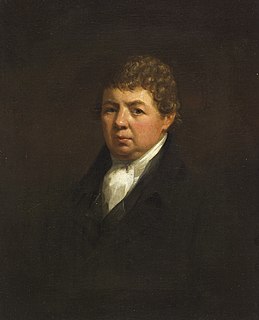
John Jamieson was a Scottish minister of religion, lexicographer, philologist and antiquary. His most important work is the Dictionary of the Scottish Language.

George Square is the principal civic square in the city of Glasgow, Scotland. It is one of six squares in the city centre, the others being Cathedral Square, St Andrew's Square, St Enoch Square, Royal Exchange Square, and Blythswood Square on Blythswood Hill.

The Scotsman is a Scottish compact newspaper and daily news website headquartered in Edinburgh. First established as a radical political paper in 1817, it began daily publication in 1855 and remained a broadsheet until August 2004. Its parent company, JPIMedia, also publishes the Edinburgh Evening News. It had an audited print circulation of 16,349 for July to December 2018. Its website, Scotsman.com, had an average of 138,000 unique visitors a day as of 2017. The title celebrated its bicentenary on 25 January 2017.
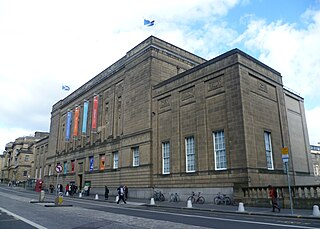
The National Library of Scotland (NLS) is the legal deposit library of Scotland and is one of the country's National Collections. As one of the largest libraries in the United Kingdom, it is a member of Research Libraries UK (RLUK) and the Consortium of European Research Libraries (CERL).
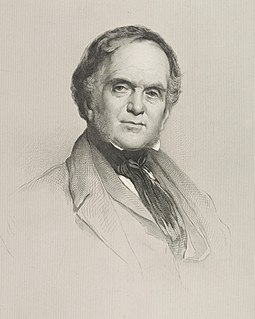
William Henry PlayfairFRSE was a prominent Scottish architect in the 19th century, who designed the Eastern, or Third, New Town and many of Edinburgh's neoclassical landmarks.

Thomas Hamilton was a Scottish architect, based in Edinburgh where he designed many of that city's prominent buildings. Born in Glasgow, his works include: the Burns Monument in Alloway; the Royal High School on the south side of Calton Hill ; the Royal College of Physicians of Edinburgh; the George IV Bridge, which spans the Cowgate; the Dean Orphan Hospital, now the Dean Gallery; the New North Road Free Church, now the Bedlam Theatre; Cumstoun, a private house in Dumfries and Galloway; and the Scottish Political Martyrs' Monument in Old Calton Cemetery, Edinburgh.
This article is intended to show a timeline of the history of Glasgow, Scotland, up to the present day.

Blackie & Son was a publishing house in Glasgow, Scotland, and London, England, from 1809 to 1991.

Macvey Napier was a Scottish solicitor, legal scholar, and an editor of the Encyclopædia Britannica. He was Professor of Conveyancing at the University of Edinburgh.

The Royal Exchange Square is a public square in Glasgow, Scotland. The square lies between Buchanan Street and Queen Street, opening out Queen Street and Ingram Street to the south of George Square. It is also easily accessible from Buchanan Street on the west side of the square, through two prominent archways at Royal Bank Place. The square is a landmark due to its distinguished architecture which attracts many visitors. It is one of six squares in the city centre.

Sir James Donaldson was a Scottish printer and newspaper publisher. He bequeathed a large part of his estate to the founding of Donaldson's Hospital.
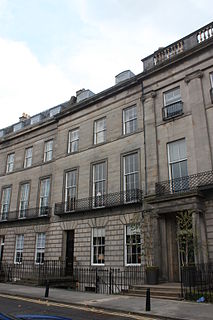
Sir John Robison KH FRSE FRSSA was a Scottish inventor and writer on scientific subjects. He was the son of the physicist and mathematician, Professor John Robison.
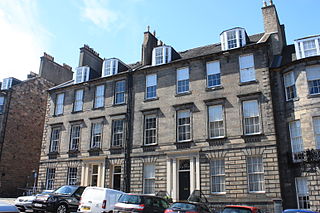
Robert Pitcairn was a Scottish antiquary and scholar who contributed to works published by Walter Scott and the Bannatyne Club. He was the author of Criminal Trials and other Proceedings before the High Court of Justiciary in Scotland (1829-1833). He was head of the Edinburgh Printing and Publishing Company and secretary of the Calvin Translating Society Pitcairn was a fellow of the Society of Antiquaries of Scotland, and a Writer to His Majesty’s Signet, and a member of the Maitland Club.
Laurence or Lawrence Craigie (c.1750–c.1833) was an 18th/19th century Scottish merchant and local politician who twice served as Lord Provost of Glasgow.
James Crystal (c.1810–c.1890) was a Scottish minister who served as Moderator of the General Assembly of the Free Church of Scotland for the period 1879 to 1880.

John Smyth (1796–1860) was a Scottish minister who served as Moderator of the General Assembly for the Free Church of Scotland 1853/54.
Walter Brown (c.1770–c.1840) was a Scottish wine merchant who served as Lord Provost of Edinburgh from 1827 to 1829.
Stephen Mitchell was a Scottish tobacco manufacturer and philanthropist. He was the founder of the Mitchell Library, in Glasgow, Lanarkshire, Scotland, one of the earliest public reference libraries in Europe. Succeeding his father in business, Mitchell was Director of Stephen Mitchell & Son for approximately 38 years, and was a significant figure in 19th-century tobacco manufacturing, then one of the largest industries in the West of Scotland.
John Coates-Campbell or John Coats Campbell of Clathick (1721–1804) was an 18th century Scottish merchant and philanthropist who served as Lord Provost of Glasgow 1788 to 1790.

The Ship Bank or more usually Old Ship Bank was an independent bank formed in Glasgow in 1750: Glasgow's first bank.















